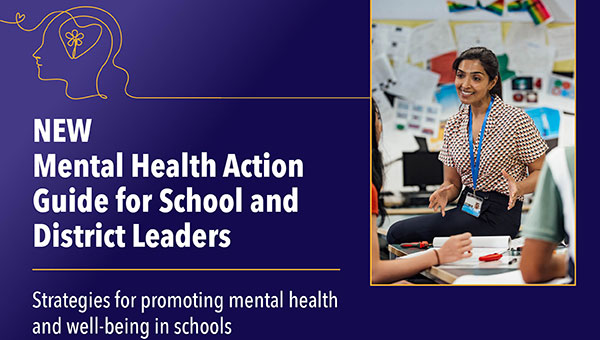As the Director of the Division of Adolescent and School Health at the Centers for Disease Control and Prevention (CDC), I know that schools play a critical role in meeting the mental and emotional health needs of our nation’s young people. I also know that parents increasingly recognize and support this role and want to be active participants in schools’ efforts to meet their young people’s needs.
This partnership between schools and parents will be key in addressing the current mental health crisis among young people. National PTA has long led the way in strengthening this important partnership, and that is why I wanted to let you know that CDC recently released a school mental health action guide to support schools in their efforts to promote students’ mental health.
The Stats on Student Mental Health
This action guide is a direct response to recent Youth Risk Behavior Survey findings, which show that adolescent mental health has been worsening for more than a decade and that key indicators of poor mental health have reached alarming levels. For instance, in 2021:
- More than 4 in 10 high school students experienced depressive symptoms in the last year
- 1 in 10 students attempted suicide during the previous year
We need to listen to what our young people are telling us and take action to reverse these trends. Promoting Mental Health and Well-Being in Schools: An Action Guide for School and District Leaders was created to provide K-12 schools with strategies to help improve the mental health of their students.
Why Schools?
As you know, schools play a vital role in promoting the behavioral and mental health of students. They are grappling with the mental health of students every day and by addressing mental health in schools, we can reach many young people in one place. Because schools reach 95% of youth for most of their day, school-based strategies have the potential to improve the mental health and well-being of all young people in the U.S. And while behavioral and mental health services are essential for young people who need them, meeting the current need is a challenge–we have to promote prevention and wellness if we want to make sure we reverse the current trends we see in our data.
By taking an upstream approach and providing education and early intervention strategies designed to reach large numbers of students, schools can promote positive behavioral and mental health and help reduce the need for services.
The 6 Strategies
The action guide describes six proven in-school strategies to promote and support mental health and well-being. Schools can improve their students’ mental health and well-being by putting any of these strategies in place:
- Increase students’ mental health literacy by delivering classroom-based mental health education curricula and implementing peer-led modeling programs.
- Promote mindfulness by delivering classroom-based mindfulness education, dedicating time for students to independently practice mindfulness, and offering small group mindfulness activities.
- Promote social, emotional and behavioral learning by providing classroom instruction focused on building social skills and emotional development and offering targeted education focused on teaching social skills and emotional development.
- Enhance connectedness between students, staff and families by providing relationship-building programs.
- Provide psychosocial skills training and cognitive behavioral interventions by engaging students in coping skills training groups and promoting acceptance and commitment to change.
- Support school staff well-being by offering mindfulness-based training programs and providing therapeutic resources.
These strategies have the ability to improve the mental health and well-being of students now, and also help ensure that they go into their young adulthood with the resources they need.
What You Can Do
As leaders in the effort to support our schools and our nation’s students, I invite you to learn more about implementing these strategies by visiting CDC’s website. I also encourage you to share the action guide with your school and district leaders so that these proven strategies can benefit as many students as possible.
There is nothing more important to the future of our country than the mental health and well-being of our young people. Working together, we can build a brighter future for our students and generations of students to come.
Dr. Kathleen Ethier is the Director of the Division of Adolescent and School Health at the Centers for Disease Control and Prevention.





